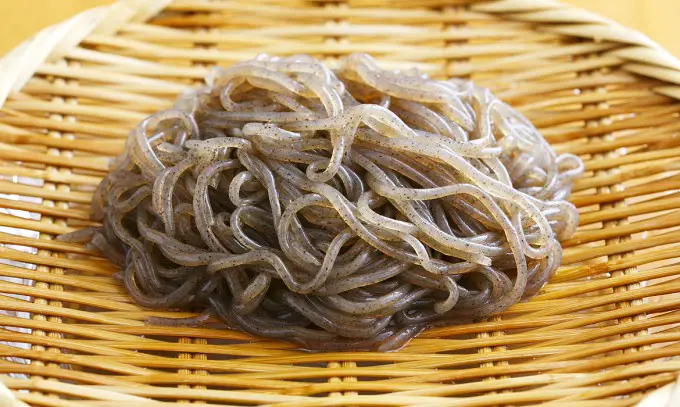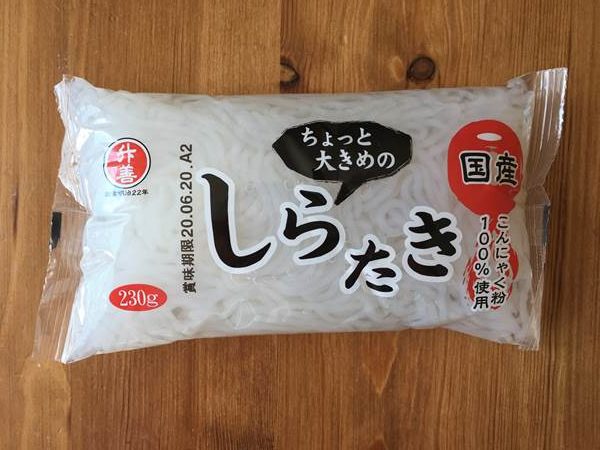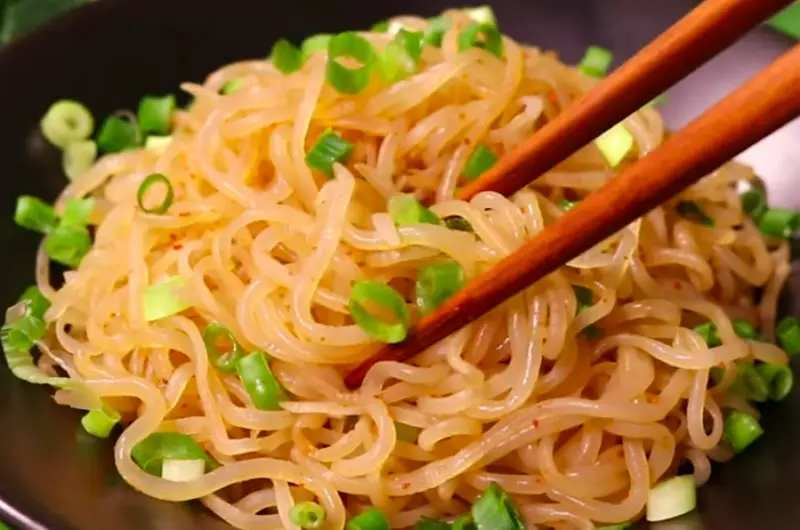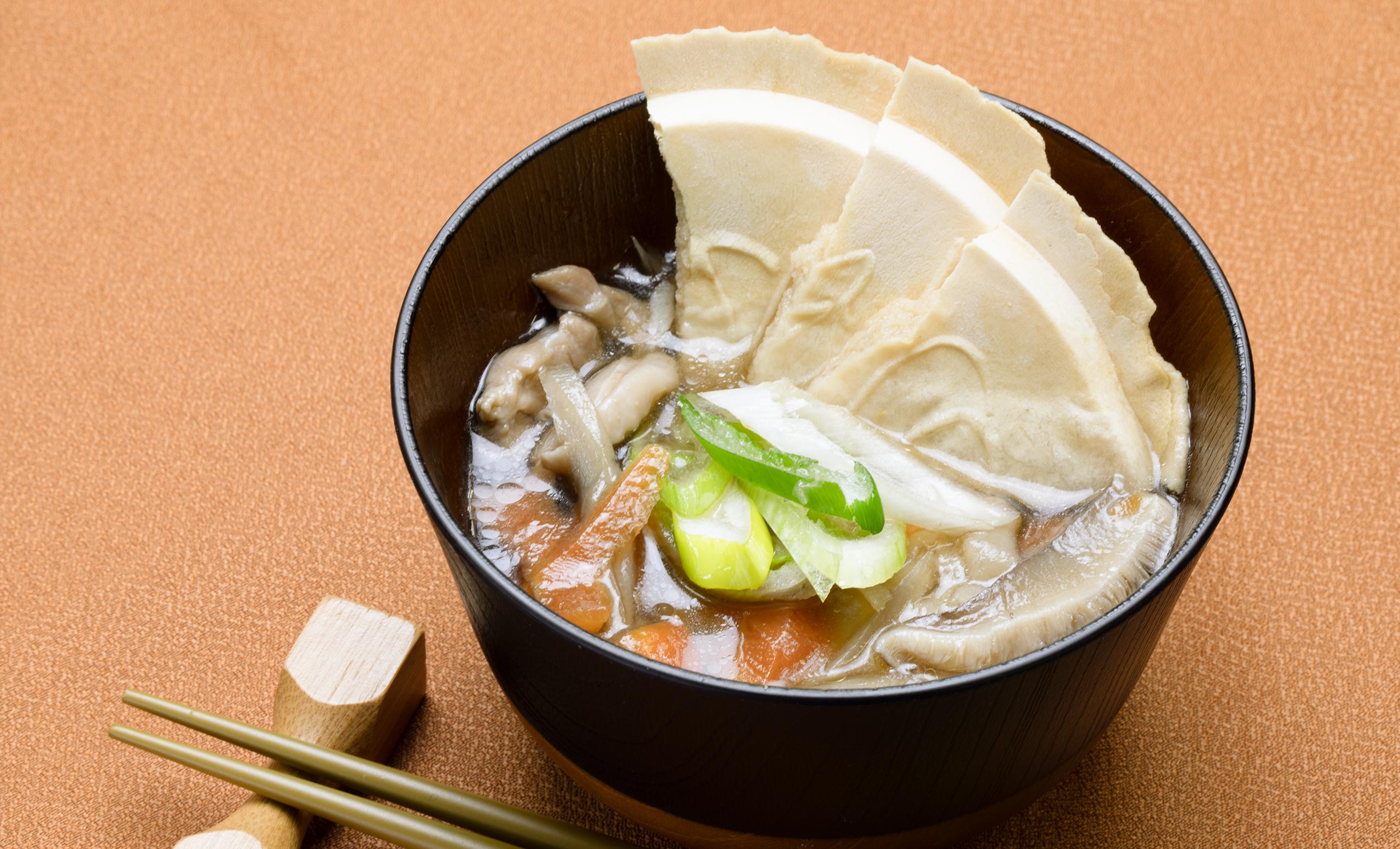
Shirataki (しらたき) is a thin Japanese noodle that is made from konjac plant / root vegetable. It is eaten all across Japan. It is very popular to use in hot pot and stew type dishes like sukiyaki.
Shirataki is gluten free, and low in calories, which makes it great for people with diet restrictions.
The name written in kanji is “白滝”, which literally translates to “white waterfall”, and is in reference to the noodles appearance when being made.
In Western Japan, shirataki is also called “ito-konnyaku” (糸こんにゃく) which means “thread konjac”.
Read on for more interesting info about shirataki:
Disclaimer: The Chef Dojo may receive a small commission if you decide to purchase products links on this page. It helps to support the website. Thanks!
Ingredients / How it’s Made

The main ingredients of Shirataki are:
- Konjac
- Water
Shirataki is made 97% of water, and 3% of konjac root.
In the past, fresh konjac was grated down, then used to make shirataki. These days, dried konjac powder is typically used, as it is easier and more cost efficient.
The ground/powdered konjac is mixed with a water/lye solution, solidified into a jelly like substance, then pushed out through a fine grate/filter to turn the block into threads (similar to making tokoroten).
When the noodles fall out from the grate, it looks like a white waterfall, hence the name “shirataki”.
Shirataki vs “Ito-Konnyaku” variations

Shirataki can be found in either white or black variations.
Some people think that the black/dark version is “ito-konnyaku” and the white version is shirataki. In the past, this may have been true, but in the present, they are actually the same thing. Both are manufactured in the exact same way.
“Shirataki” is simply the name typically used in Western Japan (Kansai Region, etc.), while “Ito-Konnyaku” is the name typically used in Eastern Japan (Kanto Region, etc.).
In the past, ito-konnyaku was manufactured slightly differently. The konjac root skin was left on, which resulted in the dark color of the noodles. The noodles were also cut (as opposed to being pushed through a strainer). This resulted in thicker noodles.
These days, konjac root powder is used to make both shirataki and ito-konnyaku. Both are also cut by being pushed small holes / strainer. For the dark version, seaweed powder is simply added for coloring.
Location / Where to Eat

Shirataki is eaten all across in Japan.
Its name may differ depending on where in Japan you are. In Eastern Japan, it is typically called shirataki. In the Western part of Japan, it may be referred to as ito-konnyaku (糸こんにゃく).
You can buy shirataki at any Japanese supermarket. It is sold as either dried (dehydrated), or ready to eat version (see image above).
Over 90% of konjac is from Gunma Prefecture (Kanto Region).1https://www.olive-hitomawashi.com/column/2018/09/post-1775.html, so if you want to try some real fresh shirataki, you should head over to Gunma.
History / Origin of Shirataki
Shirataki is said to have been eaten in Japan for over 1000 years.
The main raw ingredient (i.e. konjac) and originally cooking method is believed to have originally been brought to Japan from China.
At first, konjac was mainly used as a medicinal ingredient. Later, it was made into noodles, but only mainly eaten by Buddhist monks, and wealthy aristocrats as a vegetarian food.
When Buddhism began to spread throughout Japan, so did shirataki. During the Edo period, konjac powder was invented, which made making shirataki easier. This further helped popularize shirataki throughout the country.
Shirataki Nutrition and Health Info
Shirataki is over 95% water, so it is low in calories, carbohydrates, and fat. This makes it a popular food choice for people that want to eat noodles, but are trying to control their diet or lose weight.
Here are some other nutrition facts about shirataki2https://www.olive-hitomawashi.com/column/2021/12/post-16096.html ; https://macaro-ni.jp/97875#heading-28382552 (per 100g): 4 30 40 1 10 Here is a super easy (and delicious) stir fried shirataki recipe adapted kurashiru. Frying pan Chopsticks Shirataki … 350g Chili pepper or powder … appropriate amount Green onion … appropriate amount (for garnish) Japanese dashi powder … 1/2 tablespoon Soy sauce … 1 tablespoon Sugar … 1/2 tablespoon
Shirataki Recipe
Shirataki can be used just like any other type of noodle. It can be boiled, stewed, or stir-fried.
If you are outside of Japan, the hardest part may just be finding shirataki to buy. You can check out your local Japanese or Asian grocery store.
If you have no stores nearby (or you’re lazy to go out), you can also buy some authentic Japanese shirataki on Amazon here: House Foods Tradtional Shirataki
Below is a simple recipe to make a shirataki stir-fry via kurashiru
Super Simple Shirataki Stir-Fry
Course: MainCuisine: JapaneseDifficulty: Easy
servings
minutes
minutes
hour
minutesEquipment & Ingredients
Directions
Recipe Video
Notes
Other Fun Facts & FAQ
Are shirataki noodles really healthy?
Shirataki noodles are low in carbs, calories, and fat. It is also a good source of dietary fiber. If you are trying to lose weight, shirataki is a good alternative to other noodles, rice, or pasta.
Shirataki is not a significant source of other vitamins though, so you will need to supplement your diet with other foods.
Can you eat shirataki without cooking?
When you buy shirataki at the store, it is technically already “cooked”. You will simply need to rinse it and heat it up.
You could also eat it cold, though you may want to wash it first to remove slime/scum (depending on the type you buy).
What does shirataki taste like?
Shirataki does not really have any taste by itself (it is over 95% water). It is typically used with other ingredients, or sauces, or to “bulk” up dishes.
Summary
Have you ever tried shirataki before? What did you think of it?
Leave your thoughts and comments below!
Subscribe for free today! Receive cool recipes, my latest Japanese knife picks and learn about Japanese culture. Delivered every other week to your inbox.



Kansai=Western Japan
Kaneto=Eastern Japan
You had it backwards
Example: Kansas Ben = Western Japanese dialect